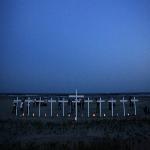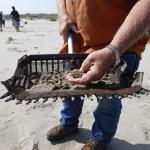2011-4-22

Photo: AP
Eleven crosses represent the workers who died in the Deepwater Horizon oil rig explosion
This is IN THE NEWS in VOA Special English.
Last year on April twentieth the Deepwater Horizon oil drilling rig exploded in flames in the Gulf of Mexico. Eleven workers were killed. Oil continued to spill from a damaged well head on the sea floor until July. It was the worst offshore oil spill in American history. Officials estimate that nearly five million barrels of oil poured into the Gulf.
Today, the surface of the water looks much like it did before the disaster. Natural micro-organisms in the water helped eat the oil and clean up the spill. Workers also used chemical dispersants to break up the oil.
But John Hocevar, a marine biologist with the environmental group Greenpeace, says most of the oil is still in the Gulf.
JOHN HOCEVAR: "It's in the water. It's on the sediment. It's on the sea floor. A lot of it is washed up into the wetlands. It is still there. It is still being eaten by marine life today."
Tar balls continue to wash up on beaches. And animal rescue teams still treat oil-covered dolphins, turtles and other creatures.
Lisa DiPinto is with the National Oceanic and Atmospheric Administration. Ms. DiPinto says the effects of such a huge spill could have been much worse. She says tests show that fish and shrimp from the Gulf are safe to eat.
LISA DiPINTO: "The seafood safety testing that I have seen has indicated everything is looking good."
But she says the recovery of the Gulf is far from complete. The full effects of the oil spill may not be known for years.
LISA DiPINTO: " We are looking at things we've probably never looked at before as the result of an oil spill. So we are looking at things in the offshore deepwater environment, as well as up through the water column and all along the shorelines."

AP
An Inspector displays oiled sand in a sifter as a cleanup crew works on Fourchon Beach in Port Fourchon, La
BP agreed last year to put twenty billion dollars into a fund to pay fishing boat owners, workers and other people affected by the spill. BP is the British-based energy company that operated the well and leased the Deepwater Horizon from the rig's owner, Transocean.
In December the federal government announced civil action against BP, Transocean and other companies connected to the spill.
Observances of the first anniversary took place along the Gulf of Mexico on Wednesday.
The spill led the Obama administration to halt deep-water drilling in the Gulf. That moratorium ended in October. But the government has given very few permits since then. Oil and gas companies say new rules prevent them from moving quickly to increase production.
Administration officials say they are preparing new rules that will do more to enforce safety and let drilling operations continue. The Gulf of Mexico provides about thirty percent of the oil produced in the United States.
President Obama says crews have made progress in cleaning up the spill, but the job is not done. He says his administration will do "whatever is necessary" to protect and restore the Gulf Coast.
And that's IN THE NEWS in VOA Special English. You can download transcripts and MP3s of all of our programs at 51voa.com. You can also find captioned videos of Special English reports at the VOA Learning English channel on YouTube. I'm Steve Ember.
___
Contributing: Greg Flakus and Rebecca Ward